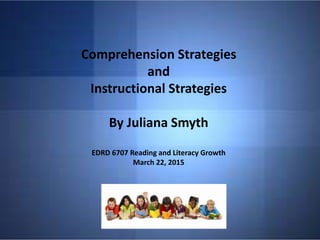
Comprehension strategies and instructional strategies
- 1. Comprehension Strategies and Instructional Strategies By Juliana Smyth EDRD 6707 Reading and Literacy Growth March 22, 2015
- 2. Comprehension Strategies for the Learner Graphic Organizers “Graphic organizers can: • Help students focus on text structure differences between fiction and nonfiction as they read • Provide students with tools they can use to examine and show relationships in a text • Help students write well-organized summaries of a text” (Adler, n.d.).
- 3. Comprehension Strategies for the Learner Fix-Up Strategy (Reutzel & Cooter, 2011, p. 309)
- 4. Comprehension Strategies for the Learner Elaborate Interrogation 1. Read each page carefully. 2. Stop at the end of each page and pick a statement. 3. Write a “why” question for the statement you pick in your reading notebooks. 4. Think about an answer to the “why” question using your own knowledge and experiences. 5. If you can, write an answer to your “why” question. 6. Read the pages again looking for an answer. Read on to another page to look for the answer. 7. If you can, write an answer to your “why” question. 8. If you can’t write an answer to your “why” question save it for group discussion after reading. (Reutzel & Cooter, 2011, p. 315).
- 5. Instructional Strategies for the Teacher Think-Pair-Share This strategy is where the teacher asks a question, students think, the students discuss, and then the students share with the whole group. (Reutzel & Cooter, 2011, p. 309)
- 6. Instructional Strategies for the Teacher Students and Teachers Actively Reading Text (START) START is an instructional framework that is implemented over a period of nine sessions where the teacher models and scaffolds the 8 comprehension strategies and the students implement the strategies for retelling before, during, and after reading. (Reutzel & Cooter, 2011, p. 302)
- 7. Instructional Strategies for the Teacher Scaffolding Strategies The diagram shows instructional strategies used to effectively teach students. These strategies can be used for any content area.
- 8. Importance of Comprehension Strategies The comprehension strategies that were chosen are appropriate for transitional, intermediate, and advanced literacy learners. Graphic organizers, fix-up strategies, and elaborate interrogation allow for the students to use metacognition while reading independently or collaboratively. These strategies also are engaging, relevant, and meaningful to comprehend a narrative or informational text that they read or was read to them.
- 9. Importance of Instructional Strategies The importance of the instructional strategies are how the content is presented to the students and under what conditions the content is presented. The instructional strategies chosen to teach comprehension of a text were Think-Pair-Share, START, and Scaffolding. All are exemplar teaching strategies, that are research-based, and appropriate to use when teaching transitional, intermediate, and advanced literacy learners. These strategies motivate and engage the readers in a text. They allow for collaboration and differentiation in the lesson.
- 10. Cognitive and Affective Aspects That Inform Comprehension There are 2 main cognitive aspects that inform comprehension: 1. Language Comprehension 2. Decoding Language comprehension refers to understanding language. Decoding is what a child uses to figure out unknown words. These cognitive elements “tend to develop congruently in a young reader’s mind and serve to reinforce each other” (SEDL, 2013) as they read.
- 11. Cognitive and Affective Aspects That Inform Comprehension Under these 2 main cognitive aspects, there is a collection of interrelated aspects that inform comprehension: 1. Cipher Knowledge-seeing patterns in words 2. Lexical Knowledge-recognizing irregular words 3. Phoneme Awareness-spoken words made up of individual sounds 4. Knowledge of Alphabetic Principle-spoken words made up of phonemes 5. Letter Knowledge-basic unit of reading and writing 6. Concepts of Print-pointing to words, beginning of sentence, where to start and stop
- 12. American Folklore: A Jigsaw Character Study Lesson The lesson I selected was “American Folklore: A Jigsaw Character Study” (International Reading Association (IRA) and National Council of Teachers of English, 2014a). I selected this lesson because it was students learning American folklore and studying character traits in a collaborative setting. The jigsaw collaborative approach is a great way for the students to use their metacognition to study the characters’ traits on a deeper level, because “metacognition is critical for reading success: It contributes to reading comprehension, and it promotes academic learning” (Afflerbach, Cho, Kim, Crassas, & Doyle, 2013). The comprehension strategy used was describing the characters in a text (story elements). The specific ways that the lesson supports comprehension for the students in class is: 1. Comparing characters in the same text/other texts 2. Problems characters have/how problems resolved 3. Character’s accomplishments/abilities 4. Supporting characters The teacher’s instructional strategy is jigsaw collaboration. The comprehension strategy the student uses is a graphic organizer for the character study.
- 13. Differences between Comprehension Strategies and Instructional Strategies Laureate Education, 2014g Comprehension Strategies • For the students • Use to understand the text • Monitoring tools for regulating,, checking, and repairing Instructional Strategies • For the teacher • Create the conditions and contexts that support reading comprehension. • Teach the individual cognitive comprehension strategies
- 14. References: Adler, C. (n.d.). Seven Strategies to Teach Students Text Comprehension. Retrieved from http://www.readingrockets.org/article/seven- strategies-teach-students-text-comprehension Afflerbach, P., Cho, B.-Y., Kim, J.-Y., Crassas, M. E., & Doyle, B. (2013). Reading: What else matters besides strategies and skills? The Reading Teacher, 66(6), 440–448. Retrieved from the Walden Library databases. International Reading Association (IRA) and National Council of Teachers of English. (2014a). ReadWriteThink. Retrieved from http://www.readwritethink.org/search/?grade=13&resource_type=6&learning_objective=8 Laureate Education (Producer). (2014g). Conversations with Ray Reutzel: Supporting comprehension [Audio file]. Baltimore, MD: Author. Reutzel, D. R., & Cooter, R. B., Jr. (2011). Strategies for reading assessment and instruction: Helping every child succeed (4th ed.). Boston, MA: Pearson. SEDL. (2013). Cognitive elements of reading. Retrieved from http://www.sedl.org/reading/framework/elements.html